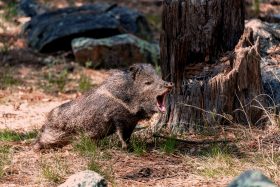SCOTTSDALE JEEP TOURS WILDLIFE: THE JAVELINA

During a Scottsdale Sonoran Desert Jeep tour, there is a likelihood that guests will have many encounters with wildlife. Arizona is home to over 800 species of wildlife, more than any non-coastal state in the United States. The diversity of wildlife comes from Arizona’s unique ecosystems that are surprisingly rich with life.
EXPLORE MORE THAN THE DESERT
One of the most unique Sonoran Desert animals that is frequently encountered on our tours is the Collared Peccary, named for a light-colored band around their neck. These animals are often called “javelina,” which is Spanish for “wild boar.” From the family Tayassuidae, the javelina has the appearance of a pig, but is not related to the European pigs that were introduced to the Americas and we all know today. Javelinas are native to the Arizona region and are found throughout Central and South America. Arizona is at the northern end of their range, and having observed javelina for some time, we figured it would be fitting to share some facts and personal experiences we’ve had with these amazingly adaptable creatures.
Their size ranges from 2-4.5 ft in length, and large boars can weigh up to 90 pounds. In general, javelina do well in multiple habitats from low desert to tall pines. Their diet consists mostly of roots, grubs, seeds, grasses, and cacti (especially the fruit) but they are opportunistic foragers and will consume almost anything. Javelina are generally not predatory animals, but will consume small animals if an opportunity presents itself. They have long, sharp canine teeth, or tusks, that give them the appearance of a predator; however, these tusks are used primarily for digging up tubers, crushing seeds, and slicing into cacti. The tusks can also be used to defend themselves and their herd against predators, such as the mountain lion, bobcat, and coyote.
A REAL DESERT ADVENTURE
“One morning while exploring a dense riparian canyon in the Mazatzal Mountains, not far from our regular Jeep tour route, I observed a herd of javelina acting very peculiar, not like I had ever seen this species act before. Upon further observation with my binoculars, I watched three individuals of the large herd work together to stomp and kill a venomous snake. Not only were they defending themselves, but they then proceeded to eat the serpent together. It was quite a remarkable sight to observe these omnivores working together to acquire a meal for the herd.” explains, Nick Goodman, a wildlife biologist and tour guide.
A quite common food source for the javelina is the prickly pear cactus, which is abundant in Arizona. These cacti have multiple pear-shaped pads that hold water and nutrition for the animals. Javelina will shred the plant by pulling and scraping out the nutrients rather than chomping on the pads. In this way, they can pull out every ounce of water and nutrition. The distinct shredded prickly pear pads are a common sight on our Jeep tours as evidence that javelina are in the area.
During the late summer and autumn months in the Sonoran Desert, the prickly pear cactus is in its fruit-bearing season. These bright red and purple fruit are an abundant source of food for the javelina. The ripe fruit is full of sugar energy and nutrients to prepare the animals for the winter. Javelina will frequently be on the prickly pear covered hillsides munching away on these delicious, decadent cactus berries, like a Thanksgiving feast.
A FIRST-HAND ACCOUNT
“One of the most exciting encounters I have had with a herd of javelina was when I discovered a large male mountain lion stalk and prey upon a very aware and defensive group. I watched the lion from a cliff in the McDowell Mountains use instinctive patience to get close enough to where he could make a successful attack, but not without great resistance. The herd of javelina defended each other valiantly. They scattered and returned multiple times to confuse the predator and defend their young. Unfortunately for one lone peccary, the lion was successful. Once the herd knew there was no escape for the unfortunate individual, they all fled the area to find cover and protection from further attack. It was concerning to see the life taken from the brave animal, yet amazing to observe nature in action with a multitude of survival tactics used by both the predator and the prey,” Nick Goodman tells.
Javelina run in small and large groups, from around five to fifteen or more individuals, which makes them very social and gives them a remarkably strong family dynamic. I am fascinated to see how they travel and look out for one another, usually with a lead and trailing male individual to protect the herd.
SEEING JAVELINAS IN THE WILD
Because of their small size and pepper colored hair, they can be difficult to spot in the dense brush where they usually live and forage, unless they are moving. If one or two are spotted, it is likely that there are many more nearby, camouflaged in the brush. If spooked, they will scatter, and this is when their numbers are revealed. They will scatter in different directions to confuse the predator but will gather later, using their strong sense of smell. They know each other’s scent, which is one of their greatest strengths for survival in the desert.
Javelina will frequently rub each other with their scent for communication, and rub objects in the area to mark a territory. When tracking the animals, it is this distinct aroma that we look for. Once you know their general location and want to close the distance without spooking them, you can call them in using a distressed piglet call. By simply making a squealing sound, many individuals of the herd will rush toward the sound to defend and protect the perceived distressed young. This is true bravery and nobility to risk their own lives to protect their family members. If the caller is not vigilant, the animals may rush in too close, creating a dangerous yet exciting situation.
JOIN OUR TOURS FOR AN UNFORGETTABLE EXPERIENCE
Arizona is full of exciting opportunities to experience wildlife, and this is just one of the many thrills that guests may encounter on a Scottsdale Sonoran Desert Jeep tour with Arizona Scottsdale Adventure Tours.
